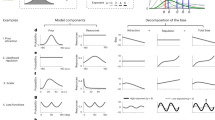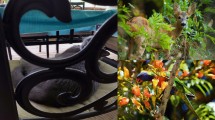Abstract
A picture viewed from its center of projection generates the same retinal image as the original scene, so the viewer perceives the scene correctly. When a picture is viewed from other locations, the retinal image specifies a different scene, but we normally do not notice the changes. We investigated the mechanism underlying this perceptual invariance by studying the perceived shapes of pictured objects viewed from various locations. We also manipulated information about the orientation of the picture surface. When binocular information for surface orientation was available, perceived shape was nearly invariant across a wide range of viewing angles. By varying the projection angle and the position of a stimulus in the picture, we found that invariance is achieved through an estimate of local surface orientation, not from geometric information in the picture. We present a model that explains invariance and other phenomena (such as perceived distortions in wide-angle pictures).
This is a preview of subscription content, access via your institution
Access options
Subscribe to this journal
Receive 12 print issues and online access
$209.00 per year
only $17.42 per issue
Buy this article
- Purchase on Springer Link
- Instant access to full article PDF
Prices may be subject to local taxes which are calculated during checkout







Similar content being viewed by others
Change history
21 November 2005
On page 1402, the first two sentences of the second full paragraph in the second column were omitted. The paragraph should have begun as follows: “An alternative explanation, the local-slant hypothesis, suggests that location of the CoP is not recovered. Instead, the observed invariance is due to an adjustment of the retinal-image shape based on measurements of the local slant of the picture surface at the point of interest. This hypothesis does not require estimates of the location of or distance to the CoP.” The PDF version of this article was corrected on 21 November 2005. Please see the PDF for details.
Notes
*On page 1402, the first two sentences of the second full paragraph in the second column were omitted. The paragraph should have begun as follows: “An alternative explanation, the local-slant hypothesis, suggests that location of the CoP is not recovered. Instead, the observed invariance is due to an adjustment of the retinal-image shape based on measurements of the local slant of the picture surface at the point of interest. This hypothesis does not require estimates of the location of or distance to the CoP.” The PDF version of this article was corrected on 21 November 2005. Please see the PDF for details.
References
da Vinci, L. The Literary Works of Leonardo da Vinci (ed. Richter, J.P.) (Phaidon, London, 1970).
Olmer, P. Tracés Pratiques (Plon, Paris, 1949).
Kubovy, M. The Psychology of Perspective and Renaissance Art (Cambridge Univ. Press, New York, 1986).
La Gournerie, J.D. Traité de Perspective Linéare Contenant les Tracés pour les Tableaux, Plans et Courbes, les Bas-reliefs et les Décorations Théatrales, avec une Théorie des Effets de Perspective (Dalmont et Dunod, Paris, 1859).
Gombrich, E.H. Art and Illusion (Princeton Univ. Press, Princeton, New Jersey, 1960).
Kingslake, R. Lenses in Photography: The Practical Guide to Optics for Photographers (Case-Hoyt, Garden City, New York, 1951).
Pirenne, M.H. Optics, Painting and Photography (Cambridge Univ. Press, Cambridge, UK, 1970).
Alesse, C. Basic 35mm Photo Guide: For Beginning Photographers (Amherst Media, New York, 1989).
Giancoli, D.C. Physics: Principles with Applications (Prentice Hall, Englewood Cliffs, New Jersey, USA, 2000).
Meister, R. The iso-deformation of images and the criterion for delimitation of the usable areas in cine-auditoriums. J. Soc. Motion Pict. Television Eng. 75, 179–182 (1966).
Zorin, D. & Barr, A.H. Correction of geometric perceptual distortions in pictures. in Proceedings of SIGGRAPH 1995 Vol. 14 (ed. Cook, R.) 257–264 (ACM SIGGRAPH/Addison-Wesley, Boston, 1995).
Caprile, B. & Torre, V. Using vanishing points for camera calibration. Int. J. Comput. Vis. 4, 127–140 (1990).
Agrawala, M., Zorin, D. & Munzner, T. Artistic multiprojection rendering. Proceedings of the 11th Europographics Rendering Workshop 11, 125–136 (2000).
Hagen, M.A. Influence of picture surface and station point on the ability to compensate for oblique view in pictorial perception. Dev. Psychol. 12, 57–63 (1976).
Rosinski, R.R. & Farber, J. Compensation for viewing point in the perception of pictured space. in The Perception of Pictures (ed. Hagen, M.A.) 137–176 (Academic, New York, 1980).
Rogers, S.J. Perceiving pictorial space. in Perception of Space and Motion (eds. Epstein, W. & Rogers, S.J.) 119–163 (Academic, San Diego, 1995).
Goldstein, E.B. Spatial layout, orientation relative to the observer, and perceived projection in pictures viewed at an angle. J. Exp. Psychol. Hum. Percept. Perform. 13, 256–266 (1987).
Cutting, J.E. Rigidity in cinema seen from the front row, side aisle. J. Exp. Psychol. Hum. Percept. Perform. 13, 323–334 (1987).
Sedgwick, H.A. The effects of viewpoint on the virtual space of pictures. in Pictorial Communication in Virtual and Real Environments (eds. Ellis, S.R., Kaiser, M.K. & Grunwald, A.C.) 460–479 (Taylor & Francis, London, 1991).
Gershun, A. The light field. J. Math. Phys. 23, 51–151 (1939).
Gibson, J.J. The Perception of the Visual World. Houghton-Mifflin, Boston, (1950).
Gårding, J. Shape from texture for smooth curved surfaces in perspective projection. J. Math. Imaging Vis. 2, 329–352 (1992).
Rosinski, R.R., Mulholland, T., Degelman, D. & Farber, J. Picture perception: An analysis of visual compensation. Percept. Psychophys. 28, 521–526 (1980).
Busey, T.A., Brady, N.P. & Cutting, J.E. Compensation is unnecessary for the perception of faces in slanted pictures. Percept. Psychophys. 48, 1–11 (1990).
Perkins, D.N. Compensating for distortion in viewing pictures obliquely. Percept. Psychophys. 14, 13–18 (1973).
Adams, K.R. Perspective and the viewpoint. Leonardo 5, 209–217 (1972).
Greene, R. Determining the preferred viewpoint in linear perspective. Leonardo 16, 97–102 (1983).
Wallach, H. & Marshall, F.J. Shape constancy in pictorial representation. Percept. Psychophys. 39, 233–235 (1986).
Stevens, K.A. Slant-tilt: The visual encoding of surface orientation. Biol. Cybern. 46, 183–195 (1983).
Koenderink, J.J. & van Doorn, A.J. Pictorial space. in Looking into Pictures: An Interdisciplinary Approach to Pictorial Space (eds. Hecht, H., Schwartz, R. & Atherton) 239–299 (MIT Press, Cambridge, Massachusetts, USA, 2003).
Kersten, D., Mamassian, P. & Yuille, A. Object perception as Bayesian Inference. Annu. Rev. Psychol. 55, 271–304 (2004).
Landy, M.S., Maloney, L.T., Johnston, E.B. & Young, M. Measurement and modeling of depth cue combination: In defense of weak fusion. Vision Res. 35, 389–412 (1995).
Knill, D.C. & Saunders, J.A. Do humans optimally integrate stereo and texture information for judgments of surface slant? Vision Res. 43, 2539–2558 (2003).
Hillis, J.M., Watt, S.J., Landy, M.S. & Banks, M.S. Slant from texture and disparity cues: optimal cue combination. J. Vis. 4, 967–992 (2004).
Burt, P. & Julesz, B. A disparity gradient limit for binocular fusion. Science 208, 615–617 (1980).
Banks, M.S., Gepshtein, S. & Landy, M.S. Why is spatial stereoresolution so low? J. Neurosci. 24, 2077–2089 (2004).
Mamassian, P. Prehension of objects oriented in three-dimensional space. Exp. Brain Res. 114, 235–245 (1997).
Thouless, R.H. Phenomenal regression to the “real” object. Br. J. Psychol. 21, 339–359 (1931).
Epstein, W.P. & Park, J.N. Shape constancy: Functional relationships and theoretical formulations. Psychol. Bull. 60, 265–288 (1963).
Regan, D. & Hamstra, S.J. Shape discrimination and the judgment of perfect symmetry: dissociation of shape from size. Vision Res. 32, 1845–1864 (1992).
Evans, F. & Narayanan, A. Immersive data visualization with the VisionDome. SPIE Visual Data Exploration and Analysis VII (SPIE, San Jose, California, USA, 2000).
Topper, D. On anamorphosis: Setting some things straight. Leonardo 33, 115–124 (2000).
Hillis, J.M. & Banks, M.S. Are corresponding points fixed? Vision Res. 41, 2457–2473 (2001).
Backus, B.T., Banks, M.S., van Ee, R. & Crowell, J.A. Horizontal and vertical disparity, eye position, and stereoscopic slant perception. Vision Res. 39, 1143–1170 (1999).
Wichmann, F.A. & Hill, N.J. The psychometric function: I. Fitting, sampling and goodness-of-fit. Perception and psychophysics. Percept. Psychophys. 63, 1293–1313 (2001).
Wichmann, F.A. & Hill, N.J. The psychometric function: II. Bootstrap-based confidence intervals and sampling. Percept. Psychophys. 63, 1314–1329 (2001).
Acknowledgements
We thank M. Landy, J. Hillis, A. Welchman, R. Fleming, S. Gepshtein and M. Ernst for comments on an earlier draft, and R. Bartholomew for technical assistance. This work was supported by NIH research grant R01-EY014194 (M.S.B.), NIH post-doctoral fellowship F32 EY14514 (D.V.) and by DOE Computational Sciences Graduate Fellowship DE-FG02-97ER25308 (A.R.G.).
Author information
Authors and Affiliations
Corresponding author
Ethics declarations
Competing interests
The authors declare no competing financial interests.
Supplementary information
Supplementary Fig. 1
Predictions and results for the first experiment for the ovoid task for two additional observers. (PDF 44 kb)
Supplementary Fig. 2
Predictions and results for a control experiment that examined the ability to judge the depicted shape of a slanted plane. (PDF 49 kb)
Supplementary Fig. 3
Predictions and results for the first experiment for the slanted-plane task for observers and conditions not shown in Fig. 3. (PDF 90 kb)
Supplementary Fig. 4
Predictions and results for the second experiment for the ovoid task for two additional observers. (PDF 58 kb)
Supplementary Fig. 5
The predictions and results for the second experiment for observers and conditions not shown in Fig. 5. (PDF 134 kb)
Supplementary Fig. 6
Predictions and results for an experiment, in which we looked further for evidence of pictorial compensation by creating a condition in which neither the surface-compensation nor the local-slant mechanism would be triggered. (PDF 164 kb)
Supplementary Fig. 7
Predictions and results for the third experiment for two additional observers. (PDF 77 kb)
Supplementary Fig. 8
Image files for demonstrations. (PDF 119055 kb)
Rights and permissions
About this article
Cite this article
Vishwanath, D., Girshick, A. & Banks, M. Why pictures look right when viewed from the wrong place. Nat Neurosci 8, 1401–1410 (2005). https://doi.org/10.1038/nn1553
Received:
Accepted:
Published:
Issue Date:
DOI: https://doi.org/10.1038/nn1553



